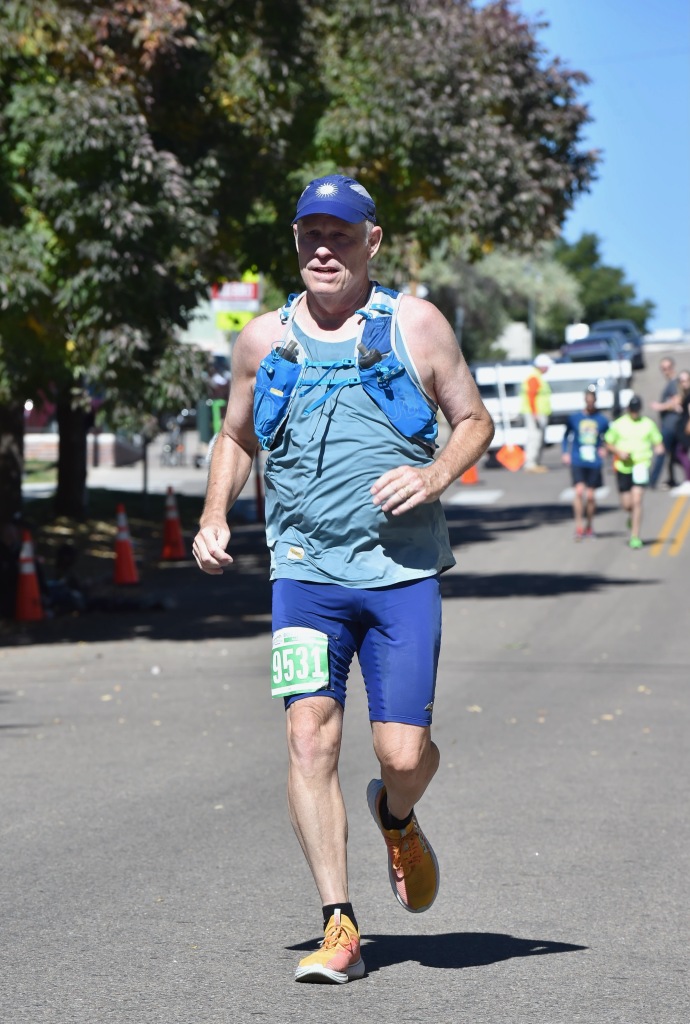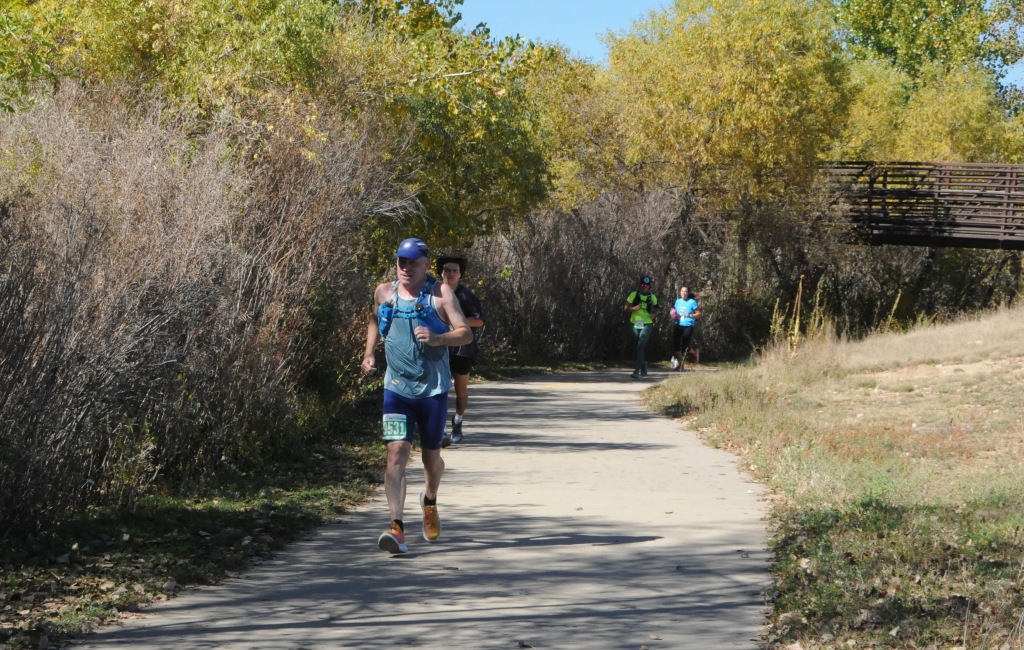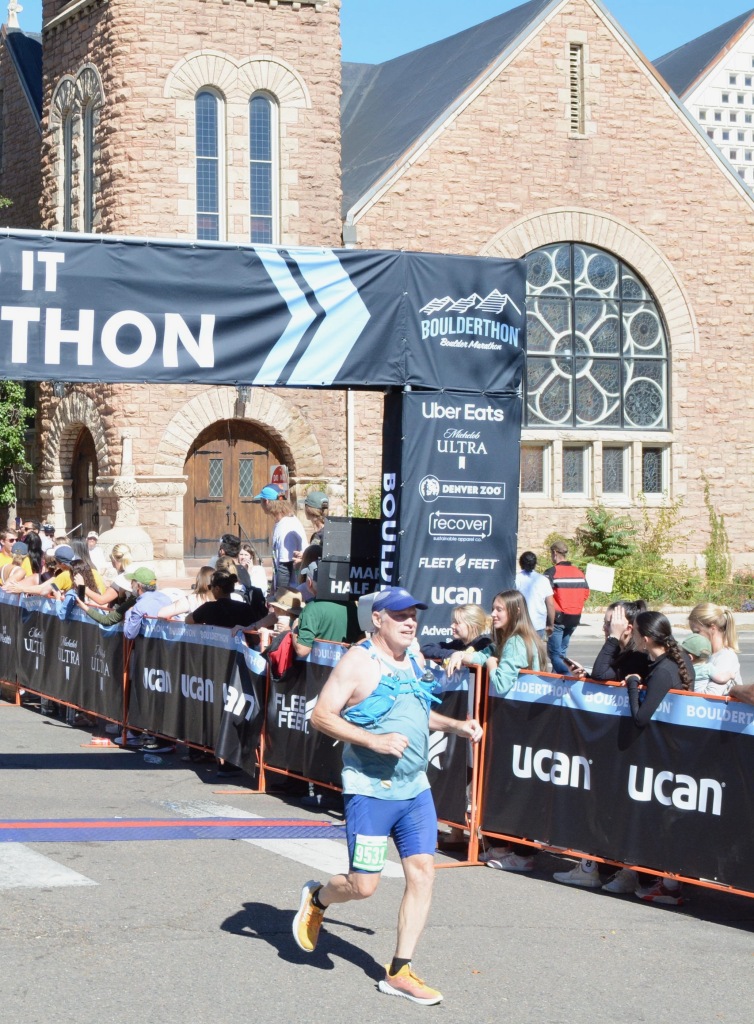Tags
The thought occurred to me while running over the brutal cement in the final 10K of the Boulder Marathon that there was no way I could run the Bandera 100K ultra. This marathon was partly intended as a stepping stone to committing to that ultra. Distance running at that magnitude is a confidence game. But pain and doubt have a way of fading over time; in this case, a couple of days, and I’m already strategerizing on how I might complete a 62 mile run in the Texas Hill Country. I’m reviewing my lessons learned. My focus has shifted from the lows I felt on that concrete to how well I ran. This is a list of my green lights.
I ran about five minutes faster than I did two years earlier, on what I believe was a tougher course. I was also about five pounds lighter I think, 185 pounds vs 190. Weight is everything in distance running. I’d want to continue to lose weight. I’d be confident in January at 175 pounds. Historically, in my older years, I’m pretty competitive at that weight. At 165, which I was for a good three or so years in my fifties, I’m on the podium in everything from a 5K to an ultra. I don’t care to drop to 165 again though because it makes me look too much like a skinny runner.
And speed is the first thing I need to get over as I train for a 100K. I think I have. I’m really comfortable and happy with my slower pace. I need to run slower yet, I need to learn how to run a 15 minute mile pace. The trick is probably running whatever pace I’m comfortable at, say 11 minutes, and then add in some walking. My fitness instructor buddy Rob suggested that approach to me. I’ll figure that out this fall.
Next is gear. I could spend all my time thinking about the right gear. Gear is fun. Between my recent backpacking and this marathon, I have a number of lessons learned. I know the socks I’m going to wear. Alpaca wool. I backpacked five days nonstop in the same pair of socks and my feet stayed dry.
And I’ve discovered a gel I can stomach. Science in Sport – SIS. It has a good amount of liquid and is almost palatable. This came to me from my ultra running son-in-law. I’m not certain I’ve settled on an electrolyte drink, I used Maurten for this event and I’m not 100% on it. I’ll be good with the Scratch served at the aid stations, I have experience with that sports drink. I might use what I carried during the marathon. I did have some slight stomach pain and I wasn’t big on the flavor. I really like my Cure, it tastes so good but it doesn’t have enough calories or electrolytes for an ultra.
I bought some SaltStick FastChews (salt tablets) that I’ll begin to train with on long runs. It’s difficult to gauge how much you sweat in Colorado. We sweat in Colorado, but it’s a dry sweat. Ultra runners get pretty scientific about it. They want to know how much salt they sweat in addition to how much they sweat. I’ll try to figure out how much salt to consume based on what amount keeps me from cramping. My muscles did fine in the marathon so I did well on electrolytes. I credit the pickle juice.
I’ve gained a sense of my pace. To my surprise, I’m pretty comfortable running a 9 minute pace, but only for a half marathon. This marathon would have been easier had I maintained a flat 10 minute pace, which was my overall pace. I want to break 17 hours in Bandara and I can do that with a 16 minute pace – over hills and rocks and hours – but still, seems like it might be in my wheel house by walking enough, well before I even need to.
I believe I’ve found the running shorts that will work. They’re essentially short tights. A TrackSmith brand that didn’t even hint at chafing. I’ll need to buy a rain jacket. Sort of learned that backpacking. Interestingly, this was the very first time I wore my bib on my shorts. I studied photos of ultra runners and they all wear their bibs on their shorts. I suspect so that they can change their shirts. I’ll be sweating in Texas, even in January with that humidity, so changing shirts often is part of my plan. I changed out from a t-shirt to a tank top half way through this marathon and it made a big difference in my comfort.
I learned that I absolutely hate my hydration vest. Gels fell out. Not enough pockets or big enough pockets. These photos show how I twisted one of the shoulder straps without knowing it. Likely when I took it off to change shirts. So, this is not a green light, and if I’m honest, it contributed to me also failing at consuming enough gels. I’m tempted to not even wear a vest. Again, studying photos of the runners at Bandera, it appeared the elites didn’t wear vests. Many wore waist packs but the aid stations are so close that they’re optional. I figure I will wear one to store a rain jacket, if the weather suggests rain, and other emergency gear, but it’s something I’m still considering. Either way, I’m buying a new one. At races where aid stations are so plentiful, I suspect it still pays to carry gels with you in order to consume them at a slower pace.
The final topic area I needed to monitor was my atrial fibrillation. I think it kicked in twice. Without my heart monitor or Apple Watch, it’s hard to know but I found myself walking twice and unable to easily catch my breath. That’s a good indicator. I just had a heart monitor patched onto my chest yesterday that I’ll wear for two weeks. The results will be helpful and should lead to a dialog with my doctor. I’ll bring up the ultra and see what he says. I don’t expect it to be an issue but I don’t really know. Time will tell.











You get an “Attaboy.” Nice work, nice evaluation. Any other comments I could make would just be self-serving and probably humorous to people who care for me.
LikeLiked by 1 person
Thanks. It felt good to run a marathon in my 60s.
LikeLike